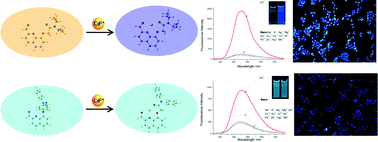Two selective fluorescent chemosensors for cadmium ions in 99% aqueous solution: the end group effect on the selectivity, DFT calculations and biological applications†
Abstract
Two fluorescent chemosensors for cadmium ions,

* Corresponding authors
a
Key Laboratory of Nonferrous Metal Chemistry and Resources Utilization of Gansu Province, State Key Laboratory of Applied Organic Chemistry and College of Chemistry and Chemical Engineering, Lanzhou University, Lanzhou, P. R. China
E-mail:
tangyu@lzu.edu.cn
Fax: (+86) 931-891-2582
b Institute of Cancer Biology and Drug Screening, School of Life Science, Lanzhou University, Lanzhou, P. R. China
Two fluorescent chemosensors for cadmium ions,

 Please wait while we load your content...
Something went wrong. Try again?
Please wait while we load your content...
Something went wrong. Try again?
H. Tian, B. Li, J. Zhu, H. Wang, Y. Li, J. Xu, J. Wang, W. Wang, Z. Sun, W. Liu, X. Huang, X. Yan, Q. Wang, X. Yao and Y. Tang, Dalton Trans., 2012, 41, 2060 DOI: 10.1039/C1DT11727K
To request permission to reproduce material from this article, please go to the Copyright Clearance Center request page.
If you are an author contributing to an RSC publication, you do not need to request permission provided correct acknowledgement is given.
If you are the author of this article, you do not need to request permission to reproduce figures and diagrams provided correct acknowledgement is given. If you want to reproduce the whole article in a third-party publication (excluding your thesis/dissertation for which permission is not required) please go to the Copyright Clearance Center request page.
Read more about how to correctly acknowledge RSC content.
 Fetching data from CrossRef.
Fetching data from CrossRef.
This may take some time to load.
Loading related content
